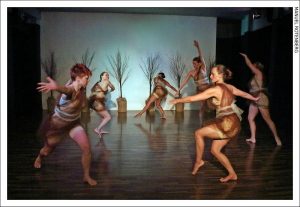Dances with Trees

The company: Cecily Holcombe, Cara Steen, Anne Gehman, Brittany Taylor, Stephanie Harvey, Viviana Alcazar. Photo: Manuel Rotenberg
Ideas for dance often come from nature. In “Bare Arm Branches,” Blythe Barton creates a stark forest narrative: six women scramble to protect their precious potted trees and ultimately find common ground.
Set to a collection of indie favorites by artists such as Andrew Bird, “Bare Arm Branches” opened with the sound of birds chirping at The Vine last weekend. The little box theater at the Rancho Bernardo Winery is an intimate space that works well for smaller dance troupes, but not during a heat wave. If real birdies had been inside the theater, they may have died from heat exhaustion.
In spite of the sauna aspects, the program was polished and attractive. Barton has a strong palette, and she’s hyper aware of floor patterns. I was impressed by the high caliber of dancing by her company, Blythe Barton Dance. Keep in mind that the troupe had already performed the work an hour before when the temperature was even higher!
Anne Gehman, smooth-skinned, broad-shouldered, was a magnetic presence. The dark-haired Viviana Alcazar was equally strong in a bluesy section marked by the women pivoting to change direction and biting a finger. Yeow.
An hour-long dance with multiple sections and no side wings did present a design challenge. Several times dancers simply walked off, there was a long pause, and then dancers found their place for the next section. In a box theater, one has to find ways to tighten the sequences, and press that play button quickly. From an audience perspective, it is far better to see the overlap than endure the gaps.
Barton is one of the hardest working dancers in town. She teaches, organizes, and performs professionally with Jean Isaacs San Diego Dance Theater and Malashock Dance. And she’s presented lots of work as an independent artist.
This production shows she’s ready for new territory, but still a bit tentative. Near the end of “Bare Arm Branches,” two dancers (Stephanie Harvey and Anne Gehman) rearranged the trees into sharp lines. Like crazed mapmakers, they skidded the trees over the floor to build new borders again and again. In future productions, one hopes Barton will make that fight for territory even more primal and aggressive.
Barton’s vocabulary is physically demanding, and her deft directorial hand drew strong performances from the company.
Unison sequences with the full ensemble were spot on. There were fun little bursts too, such as jazzy grapevines and little runs with hands on hips. Dancers didn’t stare or look through each other, they controlled their gaze.
The work would be better received on a larger stage. The group often seemed crowded. Long loose limbs needed more space to breath. Some of the lifts seemed like hiccups without height.
The most compelling sections were trios and duets, in large part because dancers had more room to move. The best interactions conjured images of tree nymphs and forest spirits, all trying to keep order, even casting spells. In one sequence, dancers lifted curved arms up the sides of a partner, as if enveloping them in a giant bubble.

Kris Eitland covers dance and theater for Sandiegostory.com and freelances for other publications, including the Union Tribune and Dance Teacher Magazine. She grew up performing many dance styles and continued intensive modern dance and choreography at the Univ. of Minnesota, Duluth, and San Diego State Univ. She also holds a journalism degree from SDSU. Her career includes stints in commercial and public radio news production.
Eitland has won numerous Excellence in Journalism awards for criticism and reporting from the San Diego Press Club. She has served on the Press Club board since 2011 and is a past president. She is a co-founder of Sandiegostory.com. She has a passion for the arts, throwing parties with dancing and singing, and cruising the Pacific in her family’s vintage trawler. She trains dogs, skis, and loves seasonal trips to her home state of Minnesota.
